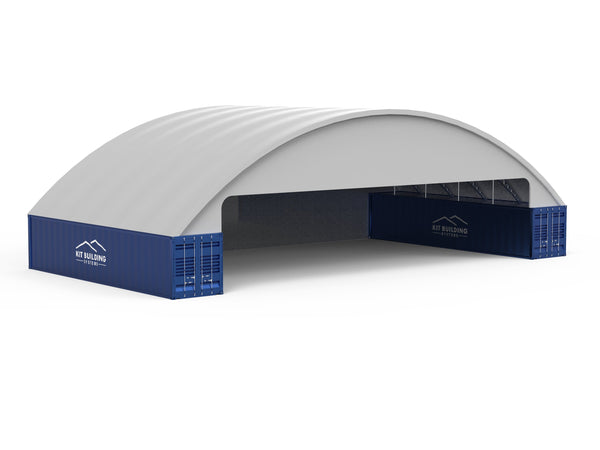Artikkel: Hvorfor landbruksbygninger er avgjørende for moderne jordbrukssuksess
Hvorfor landbruksbygninger er avgjørende for moderne jordbrukssuksess
For mange mennesker betyr jordbruk å se store åkre opplyst av gyllent sollys, høre kuer støte mykt og lukte den rene lukten av nydyrket jord. Men under denne vakre naturen er et arrangement av nødvendig infrastruktur – landbruksbygninger – som mangler fra noen synspunkter, men som er avgjørende for at hver gård skal lykkes.

Disse bygningene fungerer som hjørnesteinen for landbruksdrift, og muliggjør effektiv praksis, ideell for drivhus og barnehagerog matsikkerhet. De er mer enn bare tilfluktsrom. La oss undersøke disse 5 hovedfaktorene mer detaljert for å se hvorfor landbruksbygg er avgjørende for en vellykket gård.
- Forsvar og bevaring:
Ens verste fiende som bonde kan være været. Landbruksstrukturer fungerer som den første forsvarslinjen for avlinger, husdyr og utstyr fra tøffe værforhold som hylende vind, bitter frost og gnistrende sommersol.
Beskytte avlinger: For å unngå å bli ødelagt, trenger høstet frukt og grønnsaker spesielle kornlagre bygninger. Siloer og varehus holder et miljø under kontroll, og beskytter avlinger mot farlige skadedyr, ekstrem fuktighet og temperatursvingninger. Bønder kan administrere innhøstingen sin effektivt ved å forlenge holdbarheten til produktene og sikre minimalt tap gjennom riktig lagring.
Beskyttelse av husdyr: For å overleve krever dyr en trygg og koselig plass. Staller, løer og fjøs beskytter dyr mot dårlig vær, og forhindrer varmeutmattelse, hypotermi og skader fra hagl og sterk vind. Riktig ventilasjon og godt utformede strukturer bidrar også til å forhindre spredning av sykdom, og forbedrer helsen og velferden til dyr.
Utstyrssikkerhet: Å investere i moderne landbruksutstyr er en stor sak. For praktisk jordbruk er traktorer, hogstmaskiner, plantemaskiner og annet maskineri nødvendig. Skur og verksteder, blant annet landbruksbygg, sørge for sikker oppbevaring, beskytte maskineri mot vær og vind og unngå rust, korrosjon og værrelaterte skader. Dette reduserer reparasjonskostnadene og øker levetiden til uvurderlige maskineri.
- Logistikk og lagring:
Nøyaktig planlegging og organisering er avgjørende for en vellykket gårdsbedrift. Landbruksbygg er nødvendige for å lagre varer, opprettholde ressursflyten og øke produksjonen.
Lagerstyring: Forsyninger som bensin, gjødsel, frø og dyrefôr er nødvendig for daglig drift. Disse varene forblir ordnet og lett tilgjengelige når de oppbevares i utpekte lagringsområder som fjøs, skur eller siloer. Dette fremmer effektiv lagerkontroll, slik at bøndene kan forhindre forsinkelser og garantere en jevn strøm av forsyninger.
Sesongmessige behov: Landbrukssyklusen bestemmer når aktivitetene skal nå toppen og når de skal avta. Store avlinger må holdes under innhøsting i strukturer som kornmagasiner og kjølelager inntil de blir behandlet eller brakt til markeder. På den annen side kan måneder utenfor sesongen brukes i spesifiserte verksteder for vedlikehold og reparasjoner av utstyr, noe som garanterer at maskineriet er klart for den kommende sesongen.
Transportknutepunkter: Noen få landbruksbygg, som pakkeskur og lastekaier, er viktige ledd i forsyningskjeden. Disse strukturene gjør lasting og transport av avlinger til markeder enklere, raskt og effektivt, reduserer skader underveis og øker leveringen.
- Støtte til husdyrstell:
Med riktig infrastruktur, husdyrhold trives. Landbruksbygg har betydelig innvirkning på dyrs generelle velvære, produktivitet og helse.
Spesialiserte boliger: Hvert dyr har forskjellige krav. Hekkebokser og tilstrekkelig ventilasjon er funksjoner i fjørfehjem for høner. Komfortable boder og melkestall er kjennetegn ved melkefjøs. Disse unike konstruksjonene garanterer komforten og velferden til alle slags dyr, og fremmer best mulig utvikling og produksjon.
Kontrollerte miljøer: Noen dyr, som unge kalver eller kyllinger, trenger spesifikke temperatur- og fuktighetsnivåer i rugesesongen. Disse ideelle forholdene, levert av spesialiserte strukturer utstyrt med HVAC, ventilasjon og belysningssystemer, garanterer unge dyrs overlevelse og sunn vekst.
Bevare sanitærforhold: Hos husdyr er sykdomsforebygging avgjørende. Dedikerte strukturer med effektiv avfallshåndtering og dreneringssystemer oppmuntrer til hygiene og reduserer sjansen for at sykdommer kan spre seg blant dyr.
- Oppmuntre til verdiøkning og prosessering:
Landbruk i vår tid innebærer mer enn bare oppdrett av husdyr og avlinger. Bønder kan øke lønnsomheten ved å tilføre verdi til råvarene sine gjennom landbrukslagring.
Behandling på gården: Produsenter kan gjøre råressurser om til ferdige varer som ost, yoghurt, syltetøy eller sylteagurk ved å bruke fasiliteter som melkestaller og frukt- og grønnsaksforedlingsmaskiner. Å tilføre verdi kan øke inntjeningen deres og ta en mer betydelig del av markedsverdien.
Pakking og pakking: Riktig pakking og emballasje er avgjørende for å øke holdbarheten til produktene og redusere skader under transport. Landbruksbygg kan ha spesifikke områder for disse aktivitetene, noe som garanterer at produktene kommer frem til kunden i best mulig form.
Verdiskapende produktlagring: Behandlede varer må lagres på riktig måte før de sendes til markedet. Ost, yoghurt og syltetøy kan lagres i temperaturkontrollerte rom i landbruksbygninger for å bevare friskheten og kvaliteten til de selges.
- Fremme bærekraft og miljøansvar:
Betydningen av bærekraftige landbruksteknikker øker. Landbruksstrukturer med god utforming kan utgjøre en stor forskjell i miljøansvar.
Avfallshåndtering: Husdyrgjødsel har potensial til å avgi forurensninger. Å redusere miljøeffekter er mulig ved å konvertere avfall til fornybare energikilder i bygninger utstyrt med biogasskokere og passende gjødsellager.
Vannsparing: Det er en økende bekymring for vannmangel. Bønder kan bevare denne verdifulle ressursen ved å bruke bygninger som har vanneffektive vanningssystemer eller regnvannsoppsamlingssystemer.
Ansvarlig bruk av ressurser: Bygningsdesign og energieffektive byggematerialer kan redusere miljøbelastningen fra landbruksdrift. Bygninger kan også inneholde bærekraftige energikilder, som solcellepaneler, noe som reduserer avhengigheten av fossilt brensel.
Det siste ordet
De usungne heltene i landbruksnæringen er landbruksbygningene. De er hjørnesteinen for effektive, fruktbare og bærekraftige jordbruksmetoder i stedet for bare å tjene som tilfluktsrom. Landbruksbygg er avgjørende for å opprettholde matsikkerhet for verdens voksende befolkning fordi de tilbyr beskyttelse, legger til rette for effektiv ressursforvaltning, fremmer dyrevelferd og fremmer teknologisk integrasjon. Funksjonaliteten og utformingen av disse strukturene vil endres sammen med landbruksmetoder, og garanterer deres kontinuerlige betydning i det dynamiske jordbruksfeltet.


